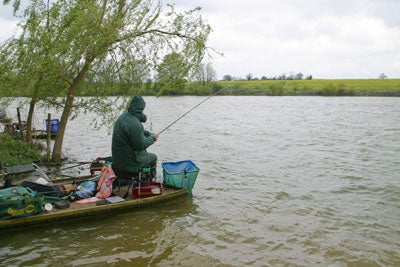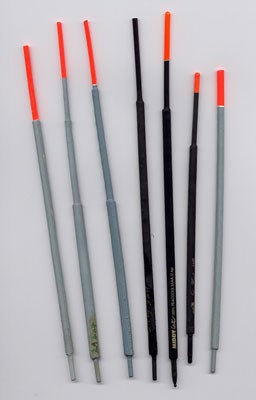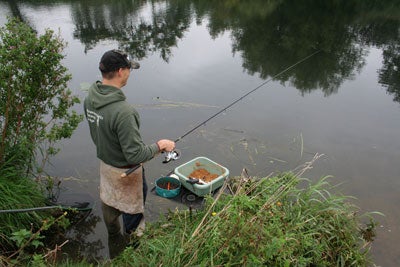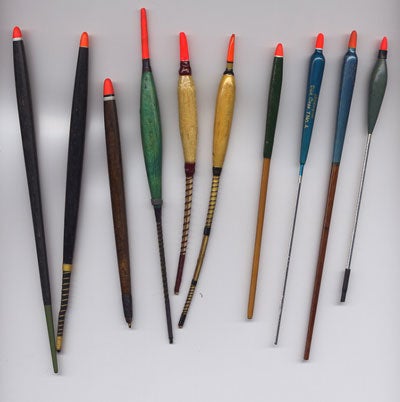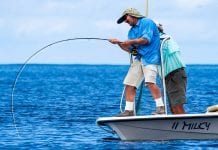| MARK WINTLE | |
|
(Beginner’s Essentials 6 – Getting Started 1)Float fishing basicsGeneralIt is wise to fish as light as you possibly can, for the least resistance you can offer fish when they take the bait the more likely they are to take it properly. But you should not fish so light you make it difficult to cast and handle the tackle.Whereas one day a float that takes no more than a couple of No.8 shot will do, another day, when the wind is blowing more strongly, two No. 8 are just not heavy enough.
Many anglers are afraid to fish heavier when conditions say they should, but what they don’t realise is that a correctly set heavier float, that handles efficiently, is much better than a lighter float that is difficult to control. So whatever you begin with, if you find you’re struggling to fish comfortably, don’t hesitate to change to a heavier float and shotting. The golden rule of float fishing is that you should place enough shot on the line to sink the float right down so as little as possible is showing above surface, providing you can still see it comfortably. This is the rule because the amount of float sticking out of the surface is roughly proportional to the amount of resistance the fish feels when it takes the bait. Many anglers think that the fish feel the shot when float fishing, but this is not strictly true for, apart from any shot that lies on the bottom, the float is actually supporting all other shot, and the only reason the float doesn’t sink completely is because of the buoyancy that remains in that tiny portion above surface. Think of it this way, if a float is shotted to the point of sinking completely, and it would take only the addition of a No.8 shot to sink it, then a fish has only to pull with a force equal to a No.8 shot to sink it too. If you can grasp that you will soon master how to select and shot floats to suit different conditions. There are two basic kinds of shotting pattern – bulked and spread. Bulked means that most of the shot are placed together, almost touching, in a bunch. Spread shot means just that; the shot are spread along the line between hook and float, not necessarily evenly. Bulk shotting is used directly under, or each side, the float when it is only required to lock and sink the float. It is used at about half depth or deeper when you want to make the bait sink as fast as possible to the bottom, or thereabouts. Or to hold the bait stationary when there is a strong undercurrent. Shot is spread when you require the bait to sink at a given rate. The smaller the shot and the more wide-spread, the slower the sinking rate. Spread shot is the most popular pattern, and is certainly the best pattern for smaller fish that regularly feed at mid-water and shallower. StillwatersProbably the best way of showing how to begin float fishing is to go through a typical procedure and a set-up suitable for a typical pool.It’s a nice day, warm, and the water flat calm. We are going to fish just beyond the rod end, so we can fish very light. An insert waggler float, slim, and 6ins long, is selected because they are amongst the most sensitive floats.
We plug this into a silicon float attachment which we have already slid onto the 2.5lb reel line, and tied a loop at the end. Now we attach a 2ft length of 2lb line to that, via another loop. At the end of the hook length we tie a 20’s spade end hook. We have a vague idea of the depth of the swim, which is about 3ft, so two BB shots are lightly pinched immediately either side the float at about 3ft from the hook. These shots are not heavy enough to make the float stand up, but are merely to lock the float in position. Then we pinch an SSG shot to the hook itself and lower it into the swim as near as possible to the spot where we aim to fish. We know that the SSG shot is heavy enough to easily sink the float and it does just that. This tells us that the float is set too shallow. So we gently slide the locking shots about 6ins up the line (after moistening the line for lubrication) and try again. This time the float sinks to about half its length, which means it is set to almost exactly the right depth. The locking shot are slid another 6ins up the line, for we want about 6ins of line lying on the bottom. The SSG shot is removed and the locking shot given another squeeze to fix them in position. A No.8 shot is pinched on 9ins from the hook. Two No.6 shot are pinched on about mid-depth and a cast is made to the swim. The float cocks but all the insert sticks above water. A further BB shot is added to the locking shot. This time just 1/8in of the insert can be seen. Just right in the calm conditions. This set-up will sink the bait quite rapidly to mid-depth, then sink more slowly to the bottom. We impale a maggot onto the hook, cast, and place the rod in the rest. A dozen maggots are thrown at the float. If we find the maggot has been sucked without us seeing a bite, then one or more of the mid-depth shot should be slid up the line to the float to allow the bait to sink more slowly. Further trial and error with the shotting pattern should follow if necessary. Feed little and often according to how well the fish are feeding. If bites slow down, slow down the feed. Respond to bites by striking, which means lifting the rod in a firm, but controlled, way; firm enough to pull the hook into the fish, but controlled to prevent line breakage. RiversFloat fishing on a river, unless the flow of the water is really slow, can be quite difficult, and should not be attempted until you have some experience of fishing on stillwaters. Rivers demand constant casting and retrieving, and continual tackle control.
A typical session on a typical river would go something like this: Two silicon float bands are slid up the 2.5lb reel line into which is slid a stick float that takes five No.4 shot. A loop is formed in the end of the line to which is tied another looped 3ft length of 2lb line. At the end of that a size 18 spade-end hook is tied. Although the float is printed to state it takes five No.4 shot we decide to use eight No. 6 shot plus one no. 8 which is the same in total weight. We pinch these on the line at 6in intervals, beginning 1ft from the hook with the no. 8, and make a cast to check. Luckily, the tip of the float can just be seen, which is just right in the smooth water. Very often the weights stated on floats are only a rough guide, and slightly more or less shot have to be used.
We cast a rod’s length out and allow the float to go with the current. After 10yds we retrieve and push the float up 6ins and cast again. After 10yds we retrieve again and push the float up another 6ins. This time the float is dragged under almost immediately as the bottom shot fouls the river bed. So the float is moved back 3ins closer to the hook, and the next trot down goes without a hitch. A single caster is hooked on and about a dozen are thrown at the head of the swim, followed by the hookbait, which we allow to go down the river for 15yds before retrieving, and throwing in another dozen or so casters and casting again. And that is the general pattern for river float fishing with a stick float. Of course, it isn’t always as simple as that, for river beds are rarely even, which means the float would be dragged under where the river bed rose, but the bait would be fishing too shallow if we set the float to make the bait miss it. Which is why most anglers fish overdepth and hold the float back to make the bait rise as it reaches the rise in the river bed. When you have some experience by all means give float fishing a try on the river. Yes, you’ll find it much more demanding than fishing on stillwaters, but it is those demands that make it so interesting and satisfying. Next Time: Legering basics |











